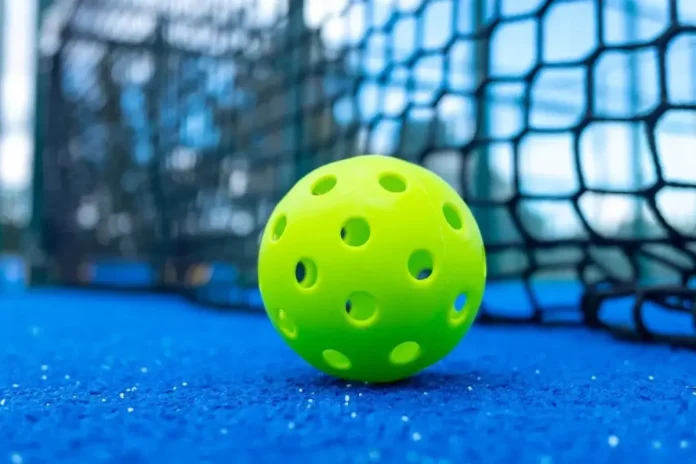Pickleball Ball Manufacturing Innovation: Pickleball’s rapid growth in the U.S. is driving new innovations in plastic manufacturing, especially for the specialized balls used in the sport. National Pickleball Day, celebrated on August 8, highlights this expanding market where plastic processors play a key role in making equipment that meets high-performance standards.
Pickleball, invented in the 1960s, is now the fastest-growing sport in the country, with participation rising over 223% since 2021. Nearly 20 million people played in 2024, making the demand for quality equipment stronger than ever. Pickleballs are made from durable plastics like polyethylene (PE) and polypropylene (PP), produced mainly by injection molding or rotational molding.
Riley Burgess, vice president of Equipment Compliance at USA Pickleball, explains that different manufacturing methods suit different players.
“Generally speaking, the rotational molded ball produces a faster ball, which is preferred by more advanced players,”. “Injection molded balls usually are more durable and slightly slower, which is better for beginner players.”(Riley Burgess)
Material Choices and Ball Design
Pickleballs vary based on their use indoors or outdoors. Angel Morales, chief development officer at Professional Pickleball Partners (Pro-Pickle), says outdoor balls, which have about 40 holes, use rotomolding for stronger, seamless construction. Indoor balls, with fewer holes (around 26), are mostly injection molded using softer PE resins for better bounce on smooth surfaces.
“Indoor surface is typically wood, as you would find in a gymnasium or basketball court.”(Angel Morales)
Outdoor balls need tougher PP materials to resist sun, temperature changes, and rough surfaces. These materials also affect how the ball flies and bounces.
Manufacturing Techniques and Quality Control
Injection molding is the main method for producing most balls. It’s faster and allows better control over product quality.
“You can produce a considerably larger number of balls in the same amount of time it takes to make roto,” (Angel Morales).
Injection-molded balls have a seam where two halves are joined, making them more affordable and popular for casual players.
Rotational molding, though more costly and complex, creates seamless balls with better performance and durability. These balls are preferred for competitive play. Pro-Pickle uses advanced molding and robotics to improve production quality and efficiency.
“We are using state-of-the-art molding, with tolerance levels unheard of in the industry, and incorporating robotics to replace the highly labor-intensive manufacturing process of rotomolding.”(Angel Morales)
Innovations in Sustainability
Sustainability is gaining attention in pickleball manufacturing. USA Pickleball’s Riley Burgess said,
“This topic has become more top of mind recently, and we will be looking into some of the recent products that have hit the market.”
Pro-Pickle launched the first 100% compostable pickleball in late 2024. Made from wheat straw and rice husk, the Compost-a-Ball breaks down in about 100 days in landfills and improves soil health. Morales shared that this ball will be the official ball of the Pickleball World Cup in Fort Lauderdale in late 2025.
Precision in Ball Performance
The hole pattern and size play a big role in ball flight and control. Indoor balls have larger holes to reduce drag indoors, while outdoor balls have more, smaller holes to handle wind better. Colors are chosen for visibility and durability—yellow and lime green dominate outdoor balls, while orange and white are common indoors.
Strict quality checks ensure that balls meet official standards for size, weight, and bounce.
“We check hardness, roundness, wall thickness, and nine other QC data points on every single batch of balls.”(Angel Morales)
Market Growth and Future Prospects
Pickleball’s popularity means companies are expanding production. Morales said Pro-Pickle is focusing on U.S. manufacturing to meet demand and reduce shipping times to Asian and European markets. Robotics will help scale production despite higher initial costs.
“The biggest factor in scaling is incorporating robotics,”. “While it will be expensive at the beginning, the increase in production will pay for itself down the road.”(Angel Morales)
The evolving pickleball market offers strong opportunities for plastic manufacturers who can deliver consistent, high-quality products to meet growing consumer needs.
News in Brief: Pickleball Ball Manufacturing Innovation
Pickleball’s fast growth fuels innovation in plastic ball manufacturing, with companies using injection and rotational molding to produce balls for beginners and pros. New sustainable balls break down quickly in landfills. Quality control is strict, and robotics are boosting production in the U.S. to meet rising demand worldwide.
ALSO READ: Pickleball Fever Sweeps Panama City Beach as All Ages Rally for National Celebration

